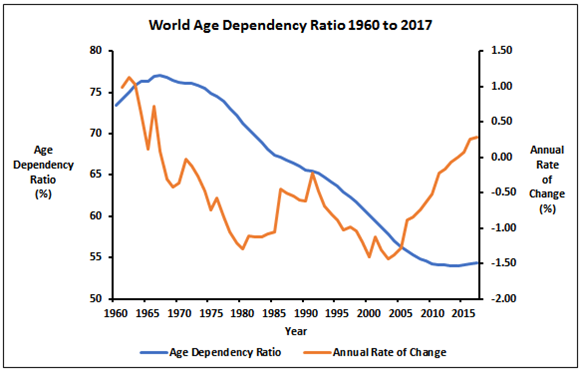Age Dependency Ratio
Revised 24 May 2019
The age dependency ratio is the ratio of the number of dependents in a population younger than 15 or older than 64 to that of the working-age population aged between 15 to 64. The age dependency ratio is given as the proportion of dependents per 100 working-age people in the population. If the age dependency ratio is 50%, then there are two working-age people in the population for each and every dependent. Figure 15 below shows the world age dependency ratio and rate of change from 1960 to 2017.
The world age dependency ratio of 73.5% in 1960 peaked to a level of 77.0% in 1967 in parallel with rapid growth in the world population and then declined monotonically to 54.0% in 2014 with a gradual increase to 54.4% by 2017. The rate of change has fluctuated with a dominant slowdown from 1980 to 1996, a speedup from 1996 to 2005, and then a second slowdown until 2014 after which the world age dependency ratio started to increase.

Figure 15: World Age Dependency Ratio and Rate of Change 1960 to 2017 (Data: United Nations 2019)
A decline in the age dependency ratio has the potential to alleviate the burden of the working-age population to support those who are dependents. Figure 7 in Sub-section: Age Composition shows the age composition of a rapid growth and a ZPG population which, for the sake of comparison, were set to be subject to the same mortality as that of the New Zealand population in 2016. Table 6 below shows the age dependency ratios for these two example populations and the world population in 2014.
Table 6: Age Dependency Ratios of a Continuous Rapid Growth, a ZPG, and the World 2014 Populations
|
|
Continuous Rapid Growth |
ZPG |
World 2014 |
|
Age Dependency Ratio (%) |
66.1 |
72.5 |
54.0 |
|
Ratio of Children under 15 to Working-Age (%) |
56.0 |
30.6 |
41.0 |
|
Ratio of Adults over 65 to Working-Age (%) |
10.1 |
41.8 |
13.0 |
|
Ratio of Children under 15 to Adults over 65 |
554:100 |
73:100 |
315:100 |
|
Average Life Expectancy (years) |
81.5 |
81.5 |
72.0 |
The world population has undergone a major transition during the 20th century. After many centuries of slow growth and then many decades of rapid growth as shown in Figure 1 in Sub-section: Introduction, the growth rate has declined more or less monotonically since 1971 as shown in Figure 5 in Sub-section: Growth Rate. The transition from a rapid growth world population prior to 1971 to a world population with a declining growth rate has resulted in a substantial decrease in the world age dependency ratio from 77.0% in 1967 to 54.0% in 2014.
The ratio of children in the world under the age of 15 in 2014 to those of working age is less than that in the continuous rapid growth population example due to a lower growth rate since 1971. The ratio of adults in the world over the age of 65 to those of working age is greater than that in continuous rapid growth population example because these cohorts are the survivors of cohorts born during a period of rapid growth before 1971 rising up through the age composition stack of cohorts. This proportion is greater even though the average life expectancy of the world population in 2014 (72.0 years) was less than that of the continuous rapid growth population example set to be 81.5 years.
The gradual increase in the world age dependency ratio from 54.0% in 2014 to 54.4% in 2017 is a signal of a further transition. The world population has yet to fully transition to a ZPG population. If the world population continues to fully transition to a ZPG population and human mortality in all countries improves to the same level as that of the New Zealand population in 2016, then the ratio of adults over the age of 65 in all countries to those of working age would eventually undergo an almost three-fold increase. The ratio of children under the age of 15 to those of working age would simultaneously undergo an almost 25% reduction. In 2014 there were almost 315 children in the world under the age of 15 for every 100 adults over the age of 65. In the above ZPG population there would be almost 73 children in the world for every 100 adults over the age of 65. The resulting age dependency ratio would increase from 54% in 2014 to about 73%.
A higher age dependency ratio might suggest an increase in the burden of the working-age population to care for dependents. However, this is not necessarily the case. A lower age dependency ratio merely indicates the potential for a larger proportion of the total population to be working for income to support dependents compared to a higher age dependency ratio. There are many factors which determine what proportion of working-age people actually do work for an income and whether the level of their income results in an increase or decrease in the burden to care for dependents. Caring for dependents also involves time and sacrifice by those who do not generate an income. Whether a reversal in the age dependency ratio to previous levels of the early 1960s would actually increase the burden of care for dependents requires close examination.